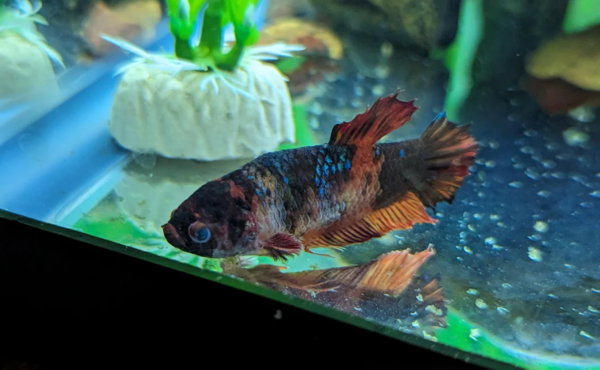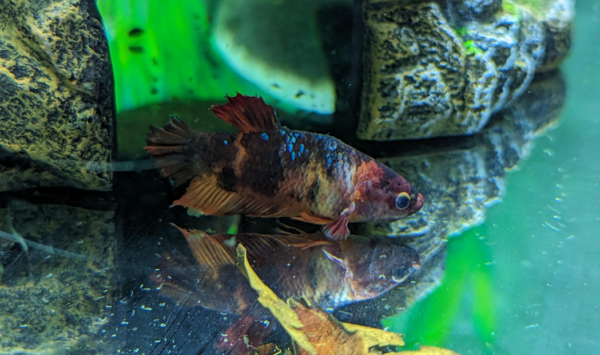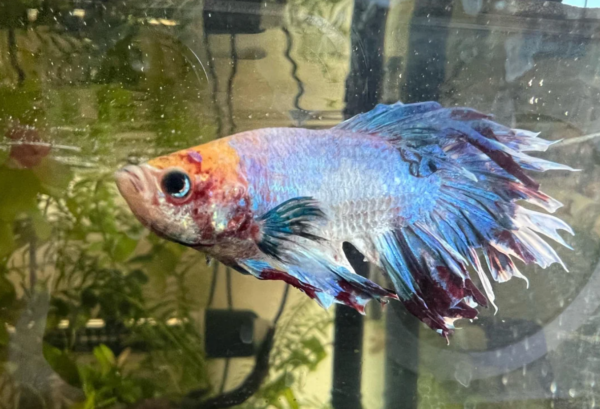We understand your frustration regarding Columnaris outbreak in your Betta tank. Whether you’re an experienced aquarist or a beginner, allowing your fish to rot away and die a horrible death is never a particularly optimum solution.
In this article, we’ll go through the nooks and crannies of Columnaris in Bettas. We’ll unravel what it is, the symptoms, prevention techniques, and some treatment options.
Table of Contents
What Is Columnaris in Bettas?

Columnaris or Cottonmouth disease or Cotton Wool disease is caused by a gram-negative bacteria (with two outer layers) called Flavobacterium Columnare. Contrary to popular belief, Columnaris in Betta or any other fish species isn’t a fungal disease and can’t be treated with available anti-fungal treatment options, such as Hikari Ich-X or Primafix.
Columnaris spreads like wildfire. Your Bettas may get it from different sources, but being non-zoonotic, Columnaris can’t develop and cause human issues. However, columnaris is ubiquitous in fresh water. It’s important to be quick and effective in administering treatments if your Betta has been affected so it can be saved from almost imminent death.
Symptoms of Columnaris in Betta
Columnaris in Bettas is a fatal disease, which can kill your fish within 24 to 48 hours of showing the first symptoms. Therefore, your impromptu action in identifying it and facilitating the treatment options will mean life and death to your Bettas. Here are the symptoms that may occur during a Columnaris outbreak:
Frayed or Ragged Fins
Columnaris mostly affects the fins and gills. The once-smooth edges of your Betta’s fins may appear tattered or uneven if subjected to Columnaris. Chunks of their flowy tails might go missing, giving the tail and fins a ragged look. Overall, the fins may become shorter due to the fragility of the tissues when attacked by the Columnaris disease.
Owing to the shortened and weakened fins, swimming becomes much more difficult for the infected Bettas. They struggle to maintain the right balance in the water and consequently, tilt to one side and swim erratically. Moreover, the damaged fins offer less protection and leave the affected fish susceptible to secondary infections.
Also Read: Betta Sorority Tank Setup Guide
Patches on the Body
Columnaris starts showing slight symptoms long before rearing its ugly head. Subtle discoloration, faint patches on the body, and faded areas near the gills are among the warning signs of Columnaris in Bettas. As the infection progresses, the discolorations transform into white, horrid patches. Often these patches are raised, slimy, and have a red border around them. In severe cases, the patches grow larger, eating away the tissue, and exposing the raw flesh beneath.
These patches are uncomfortable and “painful” for the fish. Depending on the location (around the gills and fins), the raised patches may also cause breathing issues and restricted movement—severely impacting your Betta’s quality of life. The open wounds may also allow secondary infections.
Ulcers on the Skin
The initial white or grayish patches mentioned earlier can worsen, progressing into deep, open ulcers on your Betta’s skin. These ulcers can develop further into having a ragged, uneven edge, exposing the underlying deep red tissue. As the Columnaris in Bettas continue, the ulcers grow larger and deeper, creating a cratered appearance and causing severe pain to your fish.
Given how small and fragile Bettas are, Columnaris ulcers significantly impact their well-being. In addition to being extremely painful, the open wounds also welcome other infections, including ich and fungal diseases. At this stage, labored breathing, clamping fins close to the body, and loss of appetite may become prevalent.
Also Read: Betta Fish Tricks & Training – 4 Different Types Of Methods
Cloudy Patches on Gills
The rich network of blood vessels, responsible for oxygen exchange, makes healthy gills appear red and feathery. A slight paleness may appear in the initial stages of Columnaris in Bettas, which often develops into cloudy or white patches covering the entire gills. The normal smooth, feathery structure of the gills, when affected by Columnaris, is matted and clamped together—introducing necrosis and reducing oxygen flow.
Cloudy gills severely restrict air exchange and make it difficult for your Betta to breathe. The lack of air exchange often results in suffocation and electrolyte imbalance. The damaged gills, having dense blood vessels, allow pathogens to enter the circulation system and cause secondary infections.
Pop-Eye
As the Columnaris progresses, one or both eyes of your Betta will bulge outwards from their socket, especially if the infection has reached the tissues surrounding the eyes. The affected eye might become cloudy due to fluid buildup, and in some cases, might also become red due to visible bloodshot veins. The pupil of the eye may also get dilated and constricted, depending on the severity of the infection.
The bulging eye can cause irritation, pain, and cloudy vision to your Betta. It’ll become more susceptible to injuries due to the compromised vision situation. It may also make it more challenging for your Betta to find and eat food, in addition to erratic swimming and flashing.
Is Columnaris in Bettas Fatal?
If not treated, the Columnaris bacteria will feast on your Betta’s body. It can be extremely fatal, even with treatment. From the time of symptoms occurring to them becoming fatal, you have a window of 2-3 days to start the treatment.
Mortality Rate
Columnaris disease thrives in warmer water temperatures and poor water conditions. In the wild, this bacterial disease often causes the death of whole communities of aquatic creatures. Thanks to their robust immune systems, some hardy fish can fend off Columnaris, but Bettas are too sensitive to tolerate such abysmal blows to their tiny body. Start the treatments as early as possible to enhance the odds of your Betta surviving.
Also Read: Best Betta Fish Tanks To Choose From: Top 10
Factors Influencing Fatality
Here are a few factors that influence Columnaris fatality in Bettas:
- Prolonged Warmer Temperature
Optimal conditions for Columnaris growth typically fall within the temperature range of 75 to 85°F. Coincidentally, this range aligns closely with the preferred environmental parameters for Bettas and other tropical fish. Therefore, treating Columnaris infections in bettas becomes extremely challenging due to the overlapping conditions.
- Poor Water Quality
The presence of high ammonia, nitrate, or nitrite can worsen the water quality, and consecutively, your Bettas’s health. Poor water conditions, paired with low oxygen levels, weaken the Betta’s immune systems and allow Columnaris to attack violently. Frequent water changes are performed to restrict the outbreak.
- Stress
Fish can become stressed from a variety of factors, including shipping, overcrowding, new tank mates, or poor water quality. Stress weakens their immune system and makes them more susceptible to infection.
- Injury
As discussed before, open injuries and wounds provide an entry point for external bacteria and fungus to further deteriorate the situation by causing secondary infections.
- Poor Diet
A nutritious diet is important for maintaining a healthy immune system. Your Betts are more likely to get sick if they’re deficient in vitamins or other nutrients.
Long-Term Consequences
Despite proper and timely treatment, long-term consequences may occur due to Columnaris in Bettas. This includes weakening of the immune system, chronic health issues, and impact on breeding. Columnaris disease often infects internal organs and causes necrosis. The consequences involve a weakened immune system and an increased susceptibility to secondary infections.
Your Betta may also develop long-term issues, such as chronic ulcers, fin erosion, and impaired vision. Decreased fertility, reduced breeding viability, and abnormal development in offspring are also among the noticeable consequences of Columnaris in Bettas.
Source of Columnaris in Bettas

In our experience, Columnaris is omnipresent in almost every aquatic environment. Columnaris spikes that lead to fatality commonly stem from two main factors: the introduction of a different Columnaris variant into the tank or a compromised immune system in the fish. Here are the sources that can introduce a fatal strain to the tank:
Municipal Tap Water
Although treated for many pathogens, municipal tap water doesn’t specifically target Columnaris bacteria. Using a conditional that neutralizes chlorine or chloramines may help, but it may not eliminate all potential bacteria. We recommend using RO/DI water to avoid introducing novel harmful bacteria colonies to the Betta tank.
Existing Aquarium Water
If you’re using existing aquarium water to start your new Betta tank, it may introduce new virulent strains. However, using established aquarium water is a common practice and shouldn’t cause any issues if you have maintained the tank properly.
Live Plants and Decorations
Columnaris can hitchhike to your Betta tank with new live plants and decorations from other tanks. Properly disinfect the decorations and quarantine live plants before introducing them to your Betta tank.
Contaminated Equipment
When you have multiple aquariums, cross-contamination is pretty rampant. Avoid using the same net, gravel vacuum, filter media, thermometer, and other equipment in multiple tanks without properly disinfecting them.
New Fish or Creatures
Similar to live plants and decorations, new fish and other creatures (shrimp, crawfish, crabs) may also introduce Columnaris in Betta tanks. Maintain a quarantine tank and keep the new fish in it for a couple of weeks before introducing them to the primary tank.
How Columnaris in Betta Tanks Accelerates?
The introduction of Columnaris to your Betta tank is distinctly different than their proliferation to cause a full-blown pandemic. Here are the ways Columnaris spreads and evolves in fish tanks:
Direct Contact
Direct contact with fish and live creatures encourages Columnaris to reproduce and spread. The Columnaris bacteria usually gain access to essential nutrients from the water through osmotrophy, but they can directly absorb nutrients from the host fish during an infection.
Open Wounds
The presence of artificial hard plants, decorations with sharp edges, or other fish in the tank can potentially inflict physical wounds on your Betta fish, increasing their vulnerability to bacterial infections. The open wounds attract Columnaris to secrete enzymes and break down your Betta’s tissues to absorb the nutrients necessary to reproduce.
Overcrowding and Stress
Given how small and borderline abusive Betta tanks can be, overcrowding is a typical issue among beginner aquarists. Not having enough swimming space, proximity to fin-nipping fish, excessive lighting, and many other factors can introduce stress to your Betta, weakening its immune system and making it susceptible to Columnaris.
Overfeeding
Columnaris feed off of decomposing organic matter in the water, including rotting leaves, fish poop, and fish food. Overfeeding produces more bio-load (mainly poop) than your filtration can handle and may also leave uneaten food to rot. Access to ample nutrition encourages Columnaris to reproduce rapidly and create newer strains faster than your Betta’s immune system can handle.
Lower Level of Dissolved Oxygen
Overcrowding in aquariums can lead to decreased levels of dissolved oxygen (DO), compromising the overall oxygen saturation in the water. A lower oxygen level, however, doesn’t directly cause Columnaris to flourish. But, as Columnaris bacteria can survive in low oxygen environments where the fish may struggle, they can reside inside the gills—infecting the sensitive organs.
Prevention and Treatment for Columnaris in Bettas

Here are a few tips to prevent the spread of Columnaris in your Betta tank after you’ve quarantined your fish:
Frequent Water Change
Perform frequent water changes, like 30-50% every other day for a week to remove excess ammonia, nitrite, and nitrate buildup that can stress fish and worsen the infection. Test the water frequently to verify and adjust water parameters as necessary.
Proper Filtration System
Ensure your tank has a properly functioning filter to maintain clean water. Consider increasing water flow if possible during an outbreak.
Using RO/DI Water
Adjust RO/DI water to match the water pH and temperature and use it during water change. It’ll reduce the possibility of Columnaris or any secondary infections, as bacteria can’t survive the distillation process.
Reduce Tank Stress
Minimize disturbances around the tank to reduce stress on the fish. It’s better to keep the tank indoors and covered, away from any external stimulation, during the outbreak. Moreover, remove any tank mates that might be causing aggression or overcrowding.
Administer Antibiotics
Kanamycin or nitrofurazone are commonly used antibiotics for treating columnaris. Follow the dosage instructions carefully on the medication you choose. Administer them as medicated baths multiple times a day immediately after the symptoms occur. Continue the treatment for several days before reintroducing your Betta to a Columnaris-treated tank.
Short-term freshwater salt baths might also eliminate Columnaris in some cases.
Temperature Adjustment
Gradually reduce the tank temperature to around 75°F (24°C) as columnaris thrive in warmer water.
Also Read: How Long Can Betta Fish Go Without Food?
FAQs
Precaution is the best way to prevent Columnaris in Bettas. Regardless, if Columnaris infection occurs, kanamycin and nitrofurazone antibiotics are frequently used. Freshwater medicated salts also are used as a short-term bath option for Betta Columnaris.
Yes, your fish can recover from cotton wool disease only if treatments are administered immediately after the symptoms occur. However, isolate your fish from the affected environment before putting them through the medications and procedures.
Freshwater medicated salts are used only as an additional treatment option for Columnaris. Some fish species without scales are intolerant to the salt and may even die if subjected to it for a prolonged period.
The Bottom Line
We’ve discussed the symptoms of Columnaris in Betta and the prevention strategies. Hopefully, you’ll now be able to take rapid action against the growing patches on your fish’s body and help them get better with the Columnaris treatments mentioned in this article. All the best!
No related posts.

